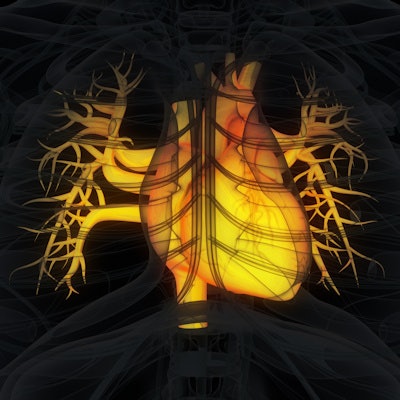
An onsite fractional flow reserve CT (FFR-CT) algorithm detected functionally significant stenosis in patients suspected of having coronary artery disease with greater accuracy than radiologists reading coronary CT angiography (CCTA) scans in a study, recently published online in Radiology: Cardiothoracic Imaging.
Though well-established as a diagnostic tool for the noninvasive detection of coronary artery disease, CCTA remains limited in its ability to determine the extent to which coronary artery stenosis indicates ischemia. This inherent drawback has given rise to FFR-CT and its growing use for the functional evaluation of coronary stenosis.
By far the most commonly used algorithm for FFR-CT measurement relies on computational fluid dynamics, a complex technique that requires clinicians to send data offsite for an hours-long analytical process. Recently, various groups have started turning to machine-learning algorithms and patient-specific lumped parameter modeling to expedite FFR-CT analysis. (The FFR-CT lumped parameter modeling method involves generating a 3D model of the coronary arteries and then simulating blood flow and pressure changes in the model to measure stenosis.)
In the current study, U.S. and Dutch researchers, led by Dr. Robbert van Hamersvelt, PhD, from the University Medical Center Utrecht, tested a prototype onsite FFR-CT lumped parameter model in a clinical setting. The model allowed them to determine functionally significant stenosis from the CCTA scans of 57 patients directly at their institution, as opposed to sending data to a third-party site (Radiol: Cardiothoracic Imaging, October 31, 2019).
The group found that the onsite FFR-CT algorithm was able to detect functionally significant stenosis much more accurately than radiologists interpreting CCTA images alone. The FFR-CT algorithm led to statistically significant increases in specificity and area under the receiver operating characteristic curve (AUC) compared with CCTA.
| Onsite FFR-CT vs. CCTA for coronary artery stenosis evaluation | ||
| CCTA | Onsite FFR-CT | |
| AUC* | 0.7 | 0.87 |
| Accuracy | 64.9% | 83.1% |
| Specificity* | 42.5% | 77.5% |
| Sensitivity | 89.2% | 89.2% |
Overall, the findings demonstrated that onsite FFR-CT was not only feasible but also diagnostically superior to CCTA for functionally significant coronary artery stenosis. What's more, the FFR-CT lumped parameter model required only eight seconds for computations and roughly 36 minutes to complete FFR-CT analysis, which is considerably less than the several hours needed for offsite measurement.
Further analysis of the data showed that the few cases for which there were notable differences between the FFR-CT and the reference-standard invasive FFR values occurred in vessels with high calcium scores (101 Agatston units or more), suggesting that the presence of high amounts of calcium in certain arteries could have lowered the accuracy of the FFR-CT algorithm.
In an accompanying commentary, Dr. Joseph Schoepf from the Medical University of South Carolina and colleagues took note of various limitations with the FFR-CT algorithm, including its reliance on extremely high-quality CCTA scans, where even slight image artifacts could disrupt accurate measurement, and its inability to assess ostial lesions.
"Despite these limitations, the results [of the current study] are further testimony to the global excitement that surrounds the refinement and clinical use of [FFR-CT]," Schoepf and colleagues wrote. "The worldwide ingenuity and zeal to develop ever-more effective and accurate [FFR-CT] algorithms is certainly inspiring, healthy, and helpful for furthering this field."



















